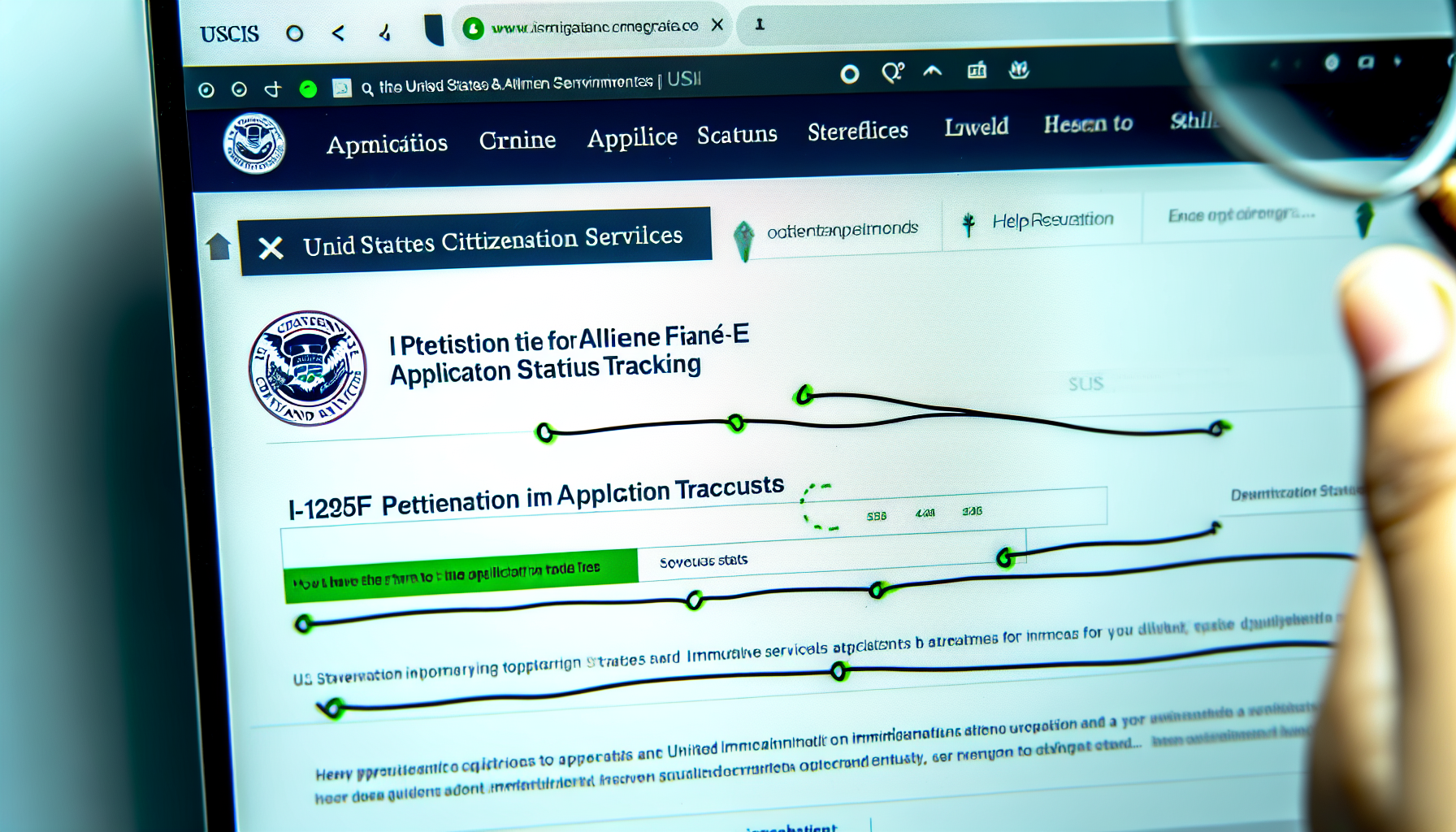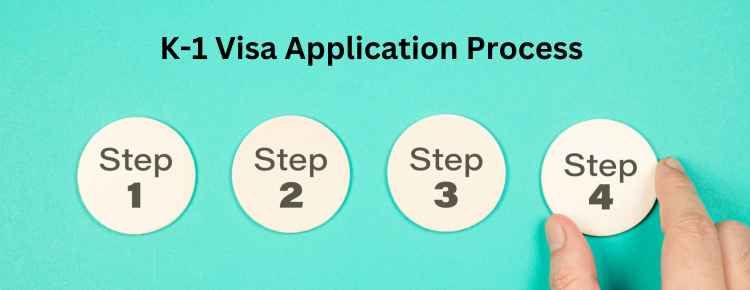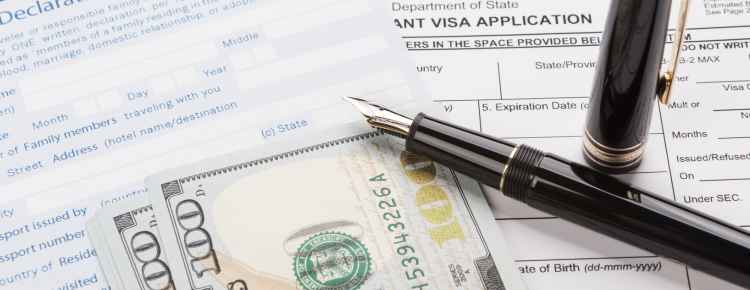Starting the K-1 visa application for your foreign fiancé(e) begins with the I-129F form. This guide provides straightforward steps to complete your I-129F accurately, avoiding errors that could delay your reunion. Get ready to learn the essentials for a seamless K-1 application journey.
Key Takeaways
- The I-129F form is crucial for the K-1 visa application process, requiring detailed information about the U.S. citizen petitioner and the foreign fiancé(e), with strict eligibility requirements including proof of a bona fide relationship and an in-person meeting within the last two years.
- Accurately completing and submitting Form I-129F, along with all the required supporting documents and the $535 fee to the USCIS Dallas lockbox, is essential for a successful petition; errors, omissions, or missing fees can cause significant delays or rejections.
- Applicants should systematically track their I-129F application status using the USCIS online tools and should prepare thoroughly for the K-1 visa interview; overcoming rejections involves responding promptly to Requests for Evidence (RFEs) or considering other options such as reapplying or appealing.
Understanding Form I-129F And Its Purpose

The I-129F form – also known as the “Petition for Alien Fiancé(e)” – is the initial step in the K-1 visa process. It’s the ticket for your foreign fiancé(e) to legally enter the U.S. with the intention of marrying you, a U.S. citizen, within 90 days of their arrival. This form is your way of establishing a qualifying relationship for your K-1 visa application.
However, this form is not merely a paperwork exercise. The I-129F demands comprehensive and precise details about both the U.S. citizen petitioner and the foreign fiancé(e). Hence, comprehending the form and its objective thoroughly is vital before commencing your K-1 visa journey.
Eligibility Requirements
Before you can petition for a K-1 visa, you need to meet certain eligibility requirements. As the petitioner, you must be a U.S. citizen – green card holders, unfortunately, are not eligible. Furthermore, both you and your foreign fiancé(e) must be legally free to marry and not have any criminal records or immigration violations.
Lastly, you must provide proof of a bona fide relationship, which includes evidence that you have met your fiancé(e) in person at least once within the two years before submitting the I-129F form. Exceptions to this requirement can be made in cases where meeting in person would violate strict and long-established customs, or cause extreme hardship to the U.S. citizen petitioning.
Key Components of Form I-129F
Having discussed eligibility, we now turn our attention to the critical elements of the I-129F form. This document collects crucial information about both you, the U.S. citizen petitioner, and your foreign fiancé(e). It’s essential to provide accurate and complete details about both parties involved, as this information forms the backbone of your K-1 visa application.
Errors or omissions at this stage could be costly. Ensuring thoroughness and accuracy now will facilitate a smoother K-1 visa journey later.
Filing Form I-129F: Step-By-Step Guide
The I-129F form submission is a painstaking process demanding your complete focus and precision. This is not a task to rush through; instead, you need to carefully read through the instructions and ensure that every answer you provide is accurate and truthful. Any small errors or omissions can lead to significant delays in your petition, or worse, cause a denial. Remember, rejections often occur due to unsigned forms, so double-check everything before you send it off.
The form should be filed at the USCIS Dallas lockbox, and while this may seem like a small detail, it’s one of many that can make or break your K-1 visa application process.
Required Supporting Documents
Alongside your I-129F form, you’ll need to provide a number of supporting documents. These include:
- Evidence of your U.S. citizenship, such as your birth certificate or an unexpired U.S. passport
- Proof of your intent to marry your fiancé(e)
- Evidence that you’ve met in person within the two years before filing, unless you’re exempt due to cultural or social practices.
Additional documents may include:
- Certified English translations for any document not in English
- Evidence to support an IMBRA waiver
- Documentation for a legal name change if applicable
- One color passport-style photograph of both you and your fiancé(e)
Submission Process and Fees
After gathering all required documents and filling out the I-129F form, the next step is submission. The form should be filed at the USCIS Dallas lockbox facility – and remember, USCIS international offices do not adjudicate the I-129F.
The filing fee for the form is $535, and it’s crucial that this is included with your submission. If you’re filing multiple forms, each filing fee must be provided separately to avoid rejection of the entire package. Finally, make sure you sign and date the form, as unsigned forms will be rejected.
Tracking Your I-129F Application Status

After your I-129F form has been submitted, it’s natural to want to keep track of your application status. You can do this by using the ‘Case Status Online’ tracker on the USCIS website, which requires your receipt number.
For a more comprehensive view of all your pending applications or petitions, you can create an account on my USCIS.
Should you require more detailed information about your case status, the California Service Center is available for inquiries through the USCIS Service Center Contact Center.
Remember, staying informed about your application status can help you anticipate any potential delays or issues and address them promptly.
Receipt Notice and Number
When USCIS accepts your I-129F form, they will typically send you a receipt notice containing a 10-digit receipt number within 30 days. This receipt number is a unique 13-character identifier that you can find on your Form I-797, Notice of Action. You can use this number to track your case status online, so keep it safe.
If you want to receive an email or text message when USCIS accepts your form, you can attach Form G-1145 to the front of your petition.
Common Reasons for Delays
While we all hope for a smooth and speedy process, delays can unfortunately occur. The processing time for K-1 fiancé visas currently ranges from 12 to 18 months, and this has noticeably increased over the past years. Other reasons for delays can include a growing number of pending I-129F cases or inconsistencies in your visa applications.
Additionally, missing USCIS appointments or failing to meet deadlines can extend the application process. Being aware of these potential pitfalls can help you avoid them and stay on track towards your K-1 visa.
Preparing For The K-1 Visa Interview

The K-1 visa interview is a significant step in your visa journey and requires ample preparation. Here are some tips to help you get ready:
- Be ready to provide a comprehensive overview of your relationship, answering detailed questions about your background, engagement, and future wedding plans.
- Organize your documents in a manner that allows easy identification and access during the interview.
- Consider seeking professional guidance to prepare for the interview.
Remember, honesty is key in your answers, and dressing appropriately can contribute to a favorable impression on the consular officer.
Scheduling the Interview
The U.S. Embassy or Consulate manages the scheduling of your K-1 visa interview and provides detailed instructions for preparation and attendance. It’s crucial to follow these instructions to the letter to avoid any potential issues. If you’re not adequately prepared for the visa interview, you could face delays or even denials, so attention to detail and compliance with all provided instructions are vital.
Note that the K-1 visa interview is mandatory, and the U.S. citizen sponsor is generally not allowed to attend. To ensure punctuality and reduce stress on the day of the interview, familiarize yourself with the location beforehand and plan to arrive early.
Necessary Documentation and Medical Exam
Before your K-1 visa interview, you’ll need to undergo a medical examination by an authorized panel physician, and it’s recommended that you get all required vaccinations. You’ll also need to provide several documents, including a passport valid for travel to the U.S., a birth certificate, divorce or death certificates of any previous spouse(s), and police certificates from your current and previous countries of residence since age 16.
Additionally, you’ll need to present evidence of your relationship with your U.S. citizen fiancé(e), and complete Form DS-160, Online Nonimmigrant Visa Application. Remember, proper preparation and staying informed about the National Visa Center can make the difference between a successful interview and a disappointing outcome.
Overcoming I-129F Rejections And Denials
While it’s a scenario we all hope to avoid, it’s important to be prepared for potential I-129F rejections and denials. About 1 in 5 applications for K1 fiancé visas was rejected in 2022, so you’re certainly not alone if you face this hurdle. Responding to requests for evidence in a timely and precise manner, appealing denials when justified, or contemplating a new application if required, are all crucial strategies.
It’s crucial to consult with an immigration lawyer in such cases, as misrepresentation of facts can result in visa denial and create problems later in the immigration process.
Request for Evidence (RFE)
A Request for Evidence (RFE) is issued by USCIS when they need additional information or clarification to proceed with your I-129F petition evaluation. If you receive an RFE, it’s important to respond by providing all requested documentation and explanations by the specified deadline. Common reasons for an RFE can include missing initial evidence, insufficient income of the sponsoring spouse, or missing proof of legal entry.
To address an RFE relating to the authenticity of your relationship, you can provide evidence such as wedding invitations, photographs, and statements from acquaintances. Remember, any non-English documents must be accompanied by certified English translations.
Appealing a Denial
If your I-129F application is denied, don’t lose heart. While nonimmigrant visa decisions, including the K-1, do not have a formal appeal procedure, you have a few options:
- You can file a request for reconsideration with the U.S. Consulate or USCIS may send the petition back for a potential new interview.
- Certain I-129F petition denials can be appealed to the U.S. immigration court.
- You may seek an immigration waiver for inadmissibility issues.
Alternatively, couples can marry outside the U.S. and apply for an immigrant visa, potentially demonstrating a higher commitment level. Each case is unique, so it’s important to explore all options available to you.
After K-1 Visa Approval: Next Steps
Once your K-1 visa has been approved, the journey isn’t over just yet. The K-1 visa holder is required to:
- Enter the United States within 6 months from the visa issuance date
- Once in the U.S., the couple must marry within 90 days of the sponsored fiancé’s arrival
- If the marriage doesn’t take place within the stipulated 90 days, the foreign-citizen fiancé must leave the United States immediately.
After marriage, the couple can then move on to the next step: applying for a marriage-based green card to make the foreign spouse a green card holder, also known as a lawful permanent resident.
Marriage Timeline and Requirements
In the midst of all the joy and excitement, don’t forget that you have a timeline to abide by. You must marry within 90 days of the sponsored fiancé’s arrival in the U.S. This might mean planning a wedding that allows for flexibility, considering a simpler ceremony that can be adjusted within this time frame.
The sponsored fiancé may also need to apply for work authorization by filing Form I-765 if they intend to work. It’s a whirlwind period, but with careful planning and adherence to the rules, you can navigate through it smoothly.
Adjusting Status and Green Card Application
After the wedding bells have rung and the confetti has settled, it’s time to focus on the next step: adjusting your status and applying for a green card. To initiate the process of becoming a lawful permanent resident, the foreign fiancé(e) should file Form I-485, Application to Register Permanent Residence or Adjust Status. Accompanying this form, you’ll need to provide a set of documents including the I-129F approval notice, marriage certificate, photos, identification, birth certificate, and Form I-693 to fulfill health requirements.
If you were married for less than two years when Form I-485 is approved, you’ll receive conditional permanent resident status and will need to file Form I-751 before the conditions can be removed.
Tips For A Smooth I-129F And K-1 Visa Process
While the I-129F and K-1 visa process can be intricate, meticulous planning and preparation can make the journey less daunting. It’s crucial to understand that the K-1 visa does not allow for a change to another nonimmigrant travel visa, and adjustment of status to a marriage-based green card is only permitted with the original U.S. citizen sponsor.
If the K-1 visa holder decides to travel outside the country before adjusting their status, they should apply for advance parole using Form I-131. This will ensure there are no issues when re-entering the country.
Thoroughly Review Form I-129F Instructions
An in-depth review of the I-129F instructions is a fundamental first step towards a successful application. It aids in clearly understanding the intent of the questions, which is crucial for providing accurate responses and maintaining the integrity of the petition. Being meticulous with your application can help prevent requests for evidence (RFEs) and avoid unnecessary delays.
No detail is too small when it comes to your K-1 visa application, so take the time to review and prepare your I-129F form thoroughly.
Provide Accurate and Complete Information
Accuracy is key when it comes to filling out your I-129F form. It’s vital to provide information that is current and truthful, as any discrepancies can lead to delays and further scrutiny of your application. Remember, submitting false information on the I-129F can lead to the form being denied, or if discovered later, can result in revocation of the visa or legal status.
Honesty is the best policy when it comes to your K-1 visa application.
Seek Professional Assistance
Although it’s feasible to handle the K-1 visa process independently, obtaining professional help can significantly enhance your prospects. An experienced immigration attorney can analyze previous application failures and provide guidance for future success. They can also offer invaluable insight on how to address potential issues and avoid visa processing delays.
Consider engaging professional citizenship and immigration services to minimize the risk of application rejection or denial and confidently navigate each step of your immigration journey.
Summary
Navigating the I-129F and K-1 visa process can be a daunting task, but with the right knowledge and preparation, it’s entirely manageable. From understanding the purpose of the I-129F form to preparing for the K-1 visa interview, each step is crucial in your journey towards uniting with your loved one. Remember, careful planning, thorough preparation, and honesty are your best allies in this process. So, arm yourself with these tips and embark on your exciting journey towards a new life together.
Frequently Asked Questions
Which is faster 129F or 130?
The Form I-129F visa application is faster than the Form I-130, with a waiting time of 10.5 to 16.5 months compared to 14.5 to 60 months, respectively.
How much is the fee for I-129F?
The fee for filing Form I-129F is $535, and there is no filing fee when filing for a K-3 spouse. Additional costs may be incurred during the K-1 visa process.
How long does it take for I-129F to be approved?
It typically takes around 6 months for the I-129F form to be approved, based on current processing times. After approval, it can take an additional four to six weeks for USCIS to transfer the case to the National Visa Center.
Who is eligible to file Form I-129F?
Only U.S. citizens are eligible to file Form I-129F. Green card holders cannot file this form. Both the petitioner and the foreign fiancé(e) must be legally free to marry and have no criminal records or immigration violations.







